
Pictor is a constellation in the Southern Celestial Hemisphere, located between the star Canopus and the Large Magellanic Cloud. Its name is Latin for painter, and is an abbreviation of the older name Equuleus Pictoris. Normally represented as an easel, Pictor was named by Abbé Nicolas-Louis de Lacaille in the 18th century. The constellation's brightest star is Alpha Pictoris, a white main-sequence star around 97 light-years away from Earth. Pictor also hosts RR Pictoris, a cataclysmic variable star system that flared up as a nova, reaching apparent (visual) magnitude 1.2 in 1925 before fading into obscurity.

EF Eridani is a variable star of the type known as polars, AM Herculis stars, or magnetic cataclysmic variable stars. Historically it has varied between apparent magnitudes 14.5 and 17.3, although since 1995 it has generally remained at the lower limit. The star system consists of a white dwarf with a substellar-mass former star in orbit.

DQ Herculis, or Nova Herculis 1934, was a slow, bright nova occurring in the northern constellation of Hercules in December 1934. This cataclysmic variable star was discovered on 13 December 1934 by J. P. M. Prentice from Stowmarket, Suffolk. It reached peak brightness on 22 December 1934 with an apparent magnitude of 1.5. The nova remained visible to the naked eye for several months.

RX Andromedae is a variable star in the constellation of Andromeda. Although it is classified as a dwarf nova of the Z Camelopardalis (UGZ) type, it has shown low-luminosity periods typical of VY Sculptoris stars. However, for most of the time it varies from an apparent visual magnitude of 15.1 at minimum brightness to a magnitude of 10.2 at maximum brightness, with a period of approximately 13 days.

Mensa is a constellation in the Southern Celestial Hemisphere near the south celestial pole, one of fourteen constellations drawn up in the 18th century by French astronomer Nicolas-Louis de Lacaille. Its name is Latin for table, though it originally commemorated Table Mountain and was known as "Mons Mensae". One of the eighty-eight constellations designated by the International Astronomical Union (IAU), it covers a keystone-shaped wedge of sky 153.5 square degrees in area. Other than the south polar constellation of Octans, it is the most southerly of constellations and is observable only south of the 5th parallel of the Northern Hemisphere.

NN Serpentis is an eclipsing post-common envelope binary system approximately 1670 light-years away. The system comprises an eclipsing white dwarf and red dwarf. The two stars orbit each other every 0.13 days.

Y Sextantis, abbreviated as Y Sex, is a variable star system in the equatorial constellation of Sextans. The system is invisible to the naked eye with a mean apparent visual magnitude of 9.88. It is located roughly at 1,300 light years from the Sun based on parallax.

QS Virginis is an eclipsing binary system approximately 163 light-years away from the Sun, forming a cataclysmic variable. The system comprises an eclipsing white dwarf and red dwarf that orbit each other every 3.37 hours.

Z Chamaeleontis is a dwarf nova variable star system approximately 394 light-years away from the Sun, where two stars orbit each other every 1.78 hours. The system comprises an eclipsing white dwarf and red dwarf and possibly a yet unconfirmed third low-mass substellar companion.

HU Aquarii is an eclipsing binary system approximately 620 light-years away from the Sun, forming a cataclysmic variable of AM Herculis-type. The two stars orbit each other every 2.08 hours and the ultra-short binary system includes an eclipsing white dwarf and red dwarf.
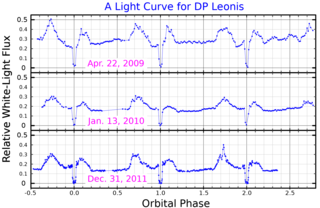
DP Leonis is a binary star system in the equatorial constellation of Leo. It is a variable star that ranges in apparent visual magnitude from 17.5 down to 19. The system is located at a distance of approximately 990 light-years from the Sun based on parallax. It is a cataclysmic variable star of the AM Herculis-type also known as polars. The system comprises an eclipsing white dwarf and red dwarf in tight orbit and an extrasolar planet. This eclipsing variable was discovered by P. Biermann and associates in 1982 as the optical counterpart to the EINSTEIN X-ray source E1114+182.
SW Sextantis variable stars are a kind of cataclysmic variable star; they are double-star systems in which there is mass transfer from a red dwarf to a white dwarf forming a stable accretion disc around the latter. Unlike other non-magnetic cataclysmic variables, the emission lines from hydrogen and helium are not doubled, except briefly near phase 0.5.
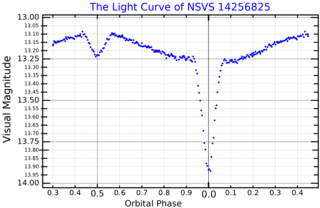
NSVS 14256825, also known as V1828 Aquilae, is an eclipsing binary system in the constellation of Aquila. The system comprises a subdwarf OB star and red dwarf star. The two stars orbit each other every 2.648976 hours. Based on the stellar parallax of the system, observed by Gaia, the system is located approximately 2,700 light-years away.

BV Centauri is a cataclysmic variable binary star in the constellation Centaurus. It is a dwarf nova, and undergoes rapid increases in brightness that are recurrent with a mean period of 150 days. This period seems to have increased in the last few decades. During quiescence, its visual apparent magnitude is about 13, with variations of a few tenths of magnitude over an orbit due to differences in the star's visible surface area, brightening to a maximum magnitude of 10.7 during outbursts. From its luminosity, it is estimated that the system is about 500 parsecs (1,600 ly) away from Earth. A Gaia parallax of 2.81 mas has been measured, corresponding to about 360 pc.

UZ Fornacis is a binary star in the constellation of Fornax. It appears exceedingly faint with a maximum apparent magnitude 17.0. Its distance, as measured by Gaia using the parallax method, is about 780 light-years.
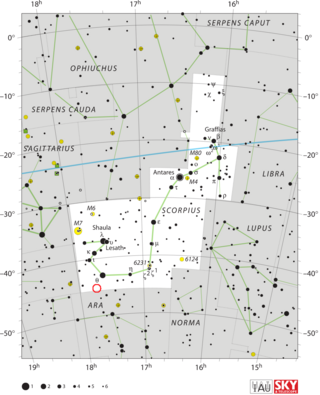
V728 Scorpii, also known as Nova Scorpii 1862, was a nova that occurred in the constellation of Scorpius. It was discovered on 4 October 1862 by John Tebbutt, an astronomer living in New South Wales, Australia, while he was observing a comet. He reported that the star was in the constellation Ara. At the time of its discovery, the nova had an apparent magnitude of 5, making it visible to the unaided eye. Nine days later it had faded to below 11th magnitude, indicating that it was a very fast nova.
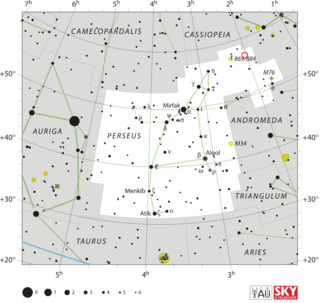
V Persei, also known as Nova Persei 1887 was discovered by Williamina Fleming on a Harvard College Observatory objective-prism photograph taken on 3 November 1887. It is believed to be the first nova whose spectrum was recorded. The nova had an apparent magnitude of 9.2 at the time of discovery. Judging from the consistency of the nova's brightness after discovery, and details of the spectral lines seen, McLaughlin estimated that the nova was five or six months past peak brightness at the time of its discovery, and at its peak it was almost certainly at least as bright as 4th magnitude. So V Persei was probably visible to the naked eye, though there is no record that anyone actually noticed it when that was possible. It is currently an 18th magnitude object.

QQ Vulpeculae is a cataclysmic variable binary star system in the northern constellation of Vulpecula, abbreviated QQ Vul. It has a brightness that fluctuates around an apparent visual magnitude of 14.7, which is too faint to be viewed with the naked eye. The distance to this system is approximately 981 light years based on parallax measurements.

OY Arae, also known as Nova Arae 1910, is a nova in the constellation Ara. It was discovered by Williamina Fleming on a Harvard Observatory photographic plate taken on April 4, 1910. At that time it had a magnitude of 6.0, making it faintly visible to the naked eye under ideal observing conditions. Examination of earlier plates showed that before the outburst it was a magnitude 17.5 object, and by March 19, 1910, it had reached magnitude 12.
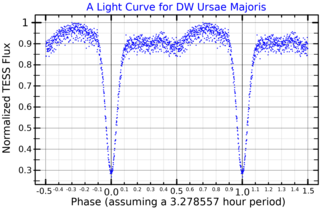
DW Ursae Majoris is an eclipsing binary star system in the northern circumpolar constellation of Ursa Major, abbreviated DW UMa. It is a cataclysmic variable of the SX Sextanis type, consisting of a compact white dwarf that is accreting matter from an orbiting companion star. The brightness of this source ranges from an apparent visual magnitude of 13.6 down to magnitude 18, which is too faint to be viewed with the naked eye. The distance to this system is approximately 1,920 light years based on parallax measurements.




















